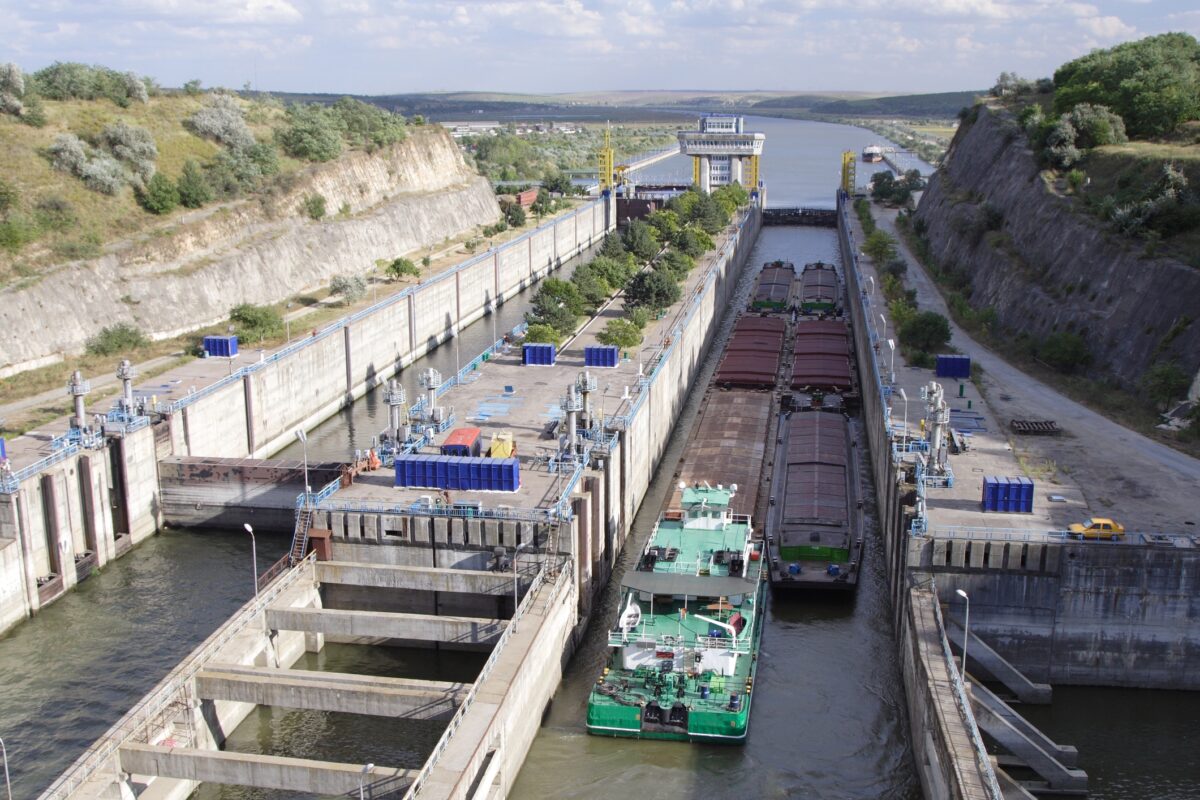The Danube‑Black Sea Canal is arguably Europe’s best‑kept logistics secret. A 64.4-kilometre shove through the flat plains of Romania, it links Cernavodă on the Danube with Constanţa’s harbour on the Black Sea.
Barges draw up to 5.5 metres, slip under 16.5-metre‑high bridges and thread two locks each 310 metres long and 25 metres wide. In theory, it could handle tens of millions of tonnes a year. In practice, it handles far less.
Construction began as a dictatorship’s pipe dream in 1949. Work stalled in 1953 amid high costs, gulag labour standards and engineering difficulties.
It lay dormant for 23 years until then Romanian leader Nicolae Ceauşescu reopened the site in 1976. Eight years and untold resources later, the canal opened with much fanfare in May 1984. It shaved 400 kilometres off the Danube’s winding Sulina branch and offered a straighter route to and from the Black Sea.
Yet the canal’s throughput remains modest, although it is increasing. In the first half of 2023, freight traffic reached 10.528 million tonnes, an 18 per cent rise on 2022. Nevertheless, the canal still performs well below potential. Danube river barges on other stretches carry far more: Austria alone saw six million tonnes in 2023, its lowest in years owing to wartime disruptions and low water.
A serious rivals to rail and road?
Supply chains are waking up. Grain is the poster child. Ukraine’s Black Sea ports have been under missile threat since 2022. Barges now trundle through the Danube Delta to be unloaded at Constanţa and reloaded for Western Europe via the canal.
Romania has helped to export roughly 29 million tonnes of Ukrainian grain through its Black Sea ports in the three years since Moscow’s invasion, becoming Ukraine’s main alternative route out.
Political winds blow both ways. Romania’s EU‑backed infrastructure push has earmarked 126 million euros for its ports and waterways, explicitly naming the Danube‑Black Sea Canal as a beneficiary.
Brussels has also proposed modernising river‑information services across the Danube, Rhine and beyond, under the Green Deal’s quest for cleaner transport. Yet domestic politics could yet trip the system. A leading presidential candidate has vowed to bar Ukrainian grain exports via Romania if elected, imperilling a vital traffic stream.
Container traffic is nascent but promising. A handful of operators have trialled feeder links, stuffing boxes at Constanţa and barrelling them west. Few carriers yet see barges as serious rivals to rail and road. But the EU’s Sustainable and Smart Mobility Strategy pushes a modal shift to waterways, which emit 10–20 times less CO2 per tonne‑kilometre than trucks.
Inland shipping is energy‑efficient and near‑congestion‑free: an offer hard to refuse when fuel are high.
Petrochemicals and fertilisers also take up canal slots. Black Sea terminals handle ammonia, urea and other feedstocks bound for Europe’s factories. Barges can parcel out smaller batches than ocean vessels, easing stockpile management. Yet canal draught limits (5.5 metres) and draft restrictions at Constanţa (around seven metres) cap flexibility.
Investment in dredging the canal’s bottom could raise depth and tonnage per trip.
Avoiding the Bosphorus
The Sulina branch of the Danube Delta is capricious. Silting demands constant dredging. By contrast, the canal offers a uniform bed and predictable schedule. Traders grumble less about waiting times. Locks are built to 7.5 metres depth and can handle 3,000 TEU in one go if loaded with containers instead of bulk cargo.
Costs are reasonable. Lock fees and canal transit tariffs undercut rail in many segments. A bulk barge from Constanţa to Vienna costs 20–25 euros per tonne, versus 35–40 euros by rail. Fuel surcharges are lower too. Harbour dues at Constanţa have been trimmed to encourage volume. Combined with modest canal fees, the total end‑to‑end bill can undercut coastal shipping plus hinterland rail.
Competition remains fierce. Romania’s other waterway, the Sulina Canal, vies for local traffic. Serbia and Bulgaria also tout their river stretches. Road and rail lobbyists press governments to rebalance subsidies. Few logistics managers have in‑house expertise in barge scheduling. Brokers are scarce. Training more skippers and harbour pilots would accelerate uptake.
Regional alliances could unlock synergies. A Danube‑Black Sea logistics corridor, tethered to the Rhine‑Main‑Danube Canal, would stitch Black Sea ports to Rotterdam. Container flows could pivot through Cernavodă, avoiding the Bosphorus and congested straits.
Raw, untapped potential
Environmental scrutiny is rising. Invasive species, from Asian clams to Chinese mitten crabs, have hitchhiked along inland waterways since the Rhine‑Main‑Danube Canal opened in 1992. The Green Danube Initiative urges careful water‑quality monitoring to stem ecological leakage. Yet proper safeguards can keep canals open while protecting biodiversity.
The untapped potential is raw. Canal capacity could swell to 30 million tonnes annually after dredging, operational upgrades and EU funding kick in. That would rival Austria’s entire Danube segment. New container feeder services might turn the canal into a mini‑Suez for Eastern Europe. Grain, chemicals, project cargoes and finished goods could all ride the same streamlined belt.
All it needs is coordination. Romania must push legislative reforms, simplify customs at Cernavodă and Constanţa, and train river pilots. Brussels should unlock cohesion funds for dredging and digital traffic management. Carriers need to trial regular liner services. Shippers must trust waterborne schedules over road‑haulier promises.
The Danube‑Black Sea Canal has slumbered for four decades. Today’s crisis in Black Sea shipping and the EU’s green mandates offer the shake‑down it needs. The rickety roads and jammed railways of the Balkans shouldn’t be the only routes out.
Barges, after all, are barges for life. The canal is ready. It just needs to be used a bit more.
Photo: Dreamstime.







